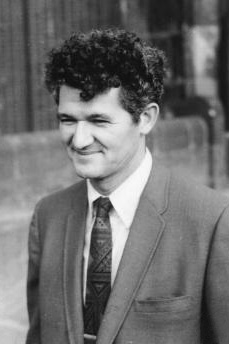Related Research Articles

Jacques Salomon Hadamard was a French mathematician who made major contributions in number theory, complex analysis, differential geometry and partial differential equations.

Solomon Lefschetz was an American mathematician who did fundamental work on algebraic topology, its applications to algebraic geometry, and the theory of non-linear ordinary differential equations.

Peter David Lax is a Hungarian-born American mathematician and Abel Prize laureate working in the areas of pure and applied mathematics.
Donald Clayton Spencer was an American mathematician, known for work on deformation theory of structures arising in differential geometry, and on several complex variables from the point of view of partial differential equations. He was born in Boulder, Colorado, and educated at the University of Colorado and MIT.
Norman Levinson was an American mathematician. Some of his major contributions were in the study of Fourier transforms, complex analysis, non-linear differential equations, number theory, and signal processing. He worked closely with Norbert Wiener in his early career. He joined the faculty of the Massachusetts Institute of Technology in 1937. In 1954, he was awarded the Bôcher Memorial Prize of the American Mathematical Society and in 1971 the Chauvenet Prize of the Mathematical Association of America for his paper A Motivated Account of an Elementary Proof of the Prime Number Theorem. In 1974 he published a paper proving that more than a third of the zeros of the Riemann zeta function lie on the critical line, a result later improved to two fifths by Conrey.

Oskar Perron was a German mathematician.
Edward Charles "Ted" Titchmarsh was a leading British mathematician.
Eliezer 'Leon' Ehrenpreis was a mathematician at Temple University who proved the Malgrange–Ehrenpreis theorem, the fundamental theorem about differential operators with constant coefficients. He previously held tenured positions at Yeshiva University and at the Courant Institute at New York University.
Joseph Fels Ritt was an American mathematician at Columbia University in the early 20th century. He was born and died in New York.

Sigurdur Helgason is an Icelandic mathematician whose research has been devoted to the geometry and analysis on symmetric spaces. In particular, he has used new integral geometric methods to establish fundamental existence theorems for differential equations on symmetric spaces as well as some new results on the representations of their isometry groups. He also introduced a Fourier transform on these spaces and proved the principal theorems for this transform, the inversion formula, the Plancherel theorem and the analog of the Paley–Wiener theorem.

Shmuel Agmon is an Israeli mathematician. He is known for his work in analysis and partial differential equations.
Henry P. McKean, Jr. is an American mathematician at the Courant Institute in New York University. He works in various areas of analysis. He obtained his PhD in 1955 from Princeton University under William Feller.
James Alexander Shohat was a Russian-American mathematician at the University of Pennsylvania who worked on the moment problem. He studied at the University of Petrograd and married the physicist Nadiascha W. Galli, the couple emigrating from Russia to the United States in 1923.
Paul Charles Rosenbloom was an American mathematician.
Rudolf Ernest Langer was an American mathematician, known for the Langer correction and as a president of the Mathematical Association of America.
Michael Eugene Taylor is an American mathematician, working in partial differential equations.
Harold Thayer Davis was a mathematician, statistician, and econometrician, known for the Davis distribution.
George Roger Sell was an American mathematician, specializing in differential equations, dynamical systems, and applications to fluid dynamics, climate modeling, control systems, and other subjects.
Victor Lenard Shapiro was an American mathematician, specializing in trigonometric series and differential equations. He is known for his two theorems on the uniqueness of multiple Fourier series.

Klaus Schmitt is an American mathematician doing research in nonlinear differential equations, and nonlinear analysis.
References
- 1 2 3 4 5 6 Alafaci, Annette. "Dancer, Edward Norman (Norman) (1946–); Biographical Entry". Encyclopedia of Australian Science.
- ↑ Edward Norman Dancer at the Mathematics Genealogy Project
- ↑ "CBN". www.cbn.umk.pl (in Polish).
- ↑ "Swansea Mathematician receives prestigious international award". www.swansea.ac.uk.
- ↑ "2009 awardees". Australian Academy of Science. Retrieved 18 March 2023.
- ↑ Dancer, E. N. (2010). "Finite Morse Index and Linearized Stable Solutions on Bounded and Unbounded Domains". Proceedings of the International Congress of Mathematicians (ICM, Hyderabad, 2010) in 4 volumes. pp. 1901–1909. doi:10.1142/9789814324359_0127. ISBN 978-981-4324-30-4.
- ↑ "Edward Norman Dancer — the winner of the 2017 Schauder Medal". Juliusz P. Schauder Center for Nonlinear Studies, Nicolaus Copernicus University in Torun.